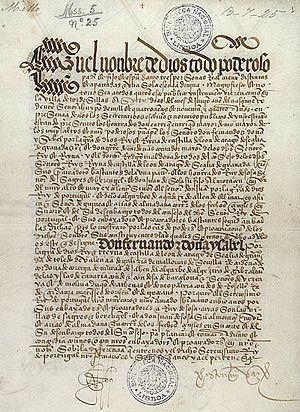Treaty facts for kids
Have you ever made an important promise with a friend, maybe about sharing toys or helping each other with homework? A treaty is a bit like that, but on a much bigger scale! It's a special written agreement between two or more important groups. These groups are usually countries, but they can also be other big organizations. Treaties are a key part of international law, which means they are rules that countries agree to follow.
Treaties can be about almost anything. For example, two countries might sign a treaty to stop a war and create peace. They might also agree to work together against a common enemy. Sometimes, treaties help people and goods move freely across borders. This means citizens or products from one country can easily enter another. Treaties are often used to solve disagreements or disputes between nations. A great example is the European Union, which was created by treaties signed by many European nations working together.
Contents
What is a Treaty?
A treaty is a formal, written promise. It's like a contract between nations. When countries sign a treaty, they agree to certain rules or actions. This helps them cooperate and avoid problems. Treaties are considered very serious. Once signed, countries are expected to follow them.
Why are Treaties Important?
Treaties play a huge role in how countries interact. They help keep the world more peaceful and organized. Here's why they matter:
- Keeping Peace: Treaties can end wars and prevent new ones from starting.
- Working Together: They allow countries to cooperate on big issues like climate change or trade.
- Setting Rules: Treaties create shared rules for things like travel, trade, and even how to treat people.
- Solving Problems: They provide a way for countries to settle disagreements without fighting.
Famous Treaties in History
Many important treaties have shaped our world. Here are some well-known examples:
- 1494 - Treaty of Tordesillas: This treaty divided new lands outside Europe between Spain and Portugal.
- 1783 - Treaty of Paris (1783): This agreement officially ended the American Revolutionary War.
- 1814 - Congress of Vienna: After a long period of wars, European leaders met to redraw borders and restore peace.
- 1840 - Treaty of Waitangi: This treaty was signed between the British Crown and Māori chiefs in New Zealand.
- 1919 - Treaty of Versailles: This treaty officially ended World War I.
- 1928 - Kellogg-Briand Pact: Many nations signed this, agreeing not to use war to solve problems.
- 1938 - Munich Agreement: This agreement tried to prevent another war in Europe, but it didn't succeed.
- 1945 - United Nations Charter: This created the United Nations, an organization for global cooperation.
- 1949 - North Atlantic Treaty: This formed NATO, a military alliance for defense.
- 1955 - Warsaw Pact: This was a military alliance of communist countries during the Cold War.
- 1968 - Nuclear Non-Proliferation Treaty: This treaty aims to stop the spread of nuclear weapons.
- 1992 - Treaty of Maastricht: This agreement created the European Union as we know it today.
- 1998 - Good Friday Agreement: This helped bring peace to Northern Ireland.
Related pages
Images for kids
-
The first two pages of the Treaty of Brest-Litovsk, in (left to right) German, Hungarian, Bulgarian, Ottoman Turkish and Russian
See also
 In Spanish: Tratado internacional para niños
In Spanish: Tratado internacional para niños



